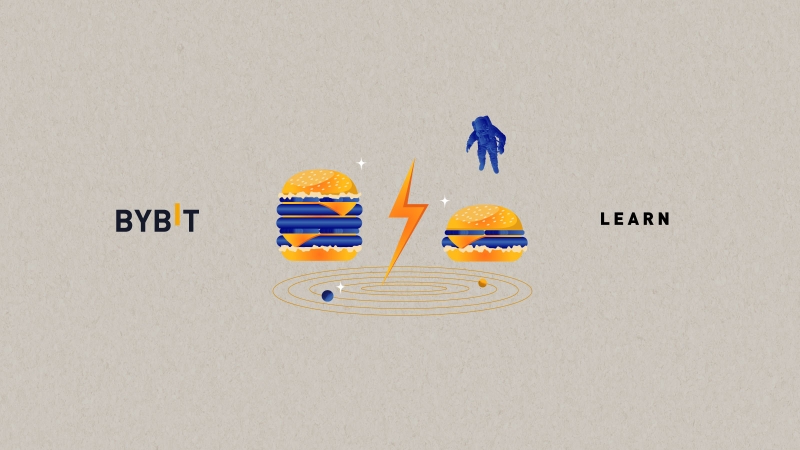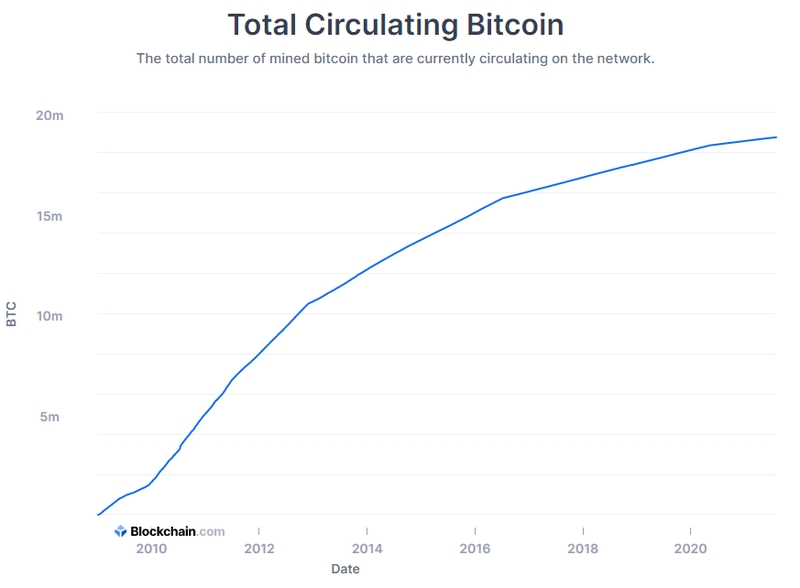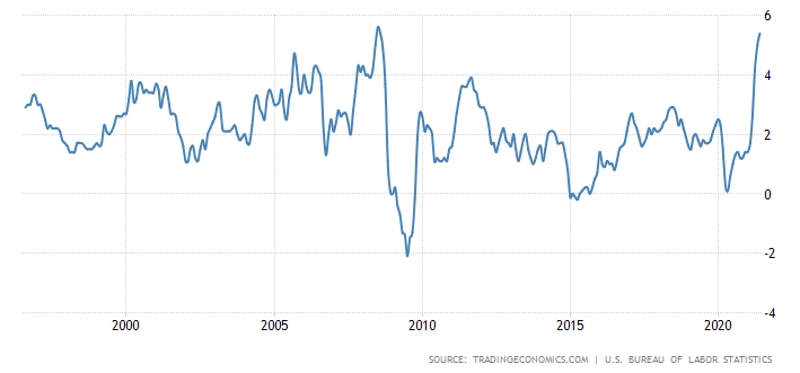Inflation vs. Deflation: The Effects on Bitcoin’s Prices
Show More
Quickly grasp the article's content and gauge market sentiment in just 30 seconds!
Inflation and its opposite, deflation, have an impact on the price of Bitcoin. The general increase in inflation tends to boost Bitcoin’s price. And when the inflation rate turns negative, deflation tends to drive the price of Bitcoin lower.
Due to the COVID-19 pandemic that results in an economic crisis, central banks around the world have been trying to stimulate the economy by printing more money. The world economy is in a cycle where central bankers are reluctant to remove money from the economy and have generally been adding more. As a result, the cycle of money printing has created an impact on Bitcoin’s price.
The Basics of Inflation and Deflation
In economics, inflation is a general rise in the price level of an economy over time. Deflation, on the other hand, is the opposite — namely, the general decline in the prices of an economy.
When you buy a loaf of bread, you’ll pay about $1.37 per pound. About 70 years ago, that bread would have cost $0.14 per pound. The price has increased nearly tenfold over the past 70 years. That price increase is due to inflation.
A little inflation of prices in an economy is positive. Inflating the prices of goods and services a little bit suggests there is an inherent demand for those products. Otherwise, when an economy experiences deflation, prices readjust lower and businesses lay off employees or go bankrupt, creating a negative feedback loop.
The topic of inflation versus deflation can be confusing to people at times. The reality is that anything can be inflated or deflated — whether a bicycle tire or prices in an economy. Therefore, it’s important to understand what is being referenced when the topics of inflation and deflation are introduced.
Inflation of Fiat Money: Supply and Credit
Most media outlets are referencing the general rise or fall in prices when they discuss inflation.
Source: in2013dollars.com
For example, the chart above illustrates how prices have inflated over the past 100 years.
When prices inflate, the purchasing power of each dollar decreases.
In the chart above, we can see purchasing power depreciate consistently over the past 100 years. The $10 in 1913 is not the same as $10 in 2021, because what you can purchase with that $10 has changed significantly. You aren’t able to buy as many goods and services with that $10 today as you could almost a century ago.
Inflation and Deflation: Cause and Effect
Could it be that the change in consumer prices is the effect of inflation and not the cause? If so, what is the cause of inflation and deflation?
A better way to look at inflation is the expansion of money in the economy. Let’s oversimplify an example: bicycles. Let’s assume the demand for new bicycles is steady from year to year, and a new bicycle costs an average of $500.
If the amount of money in the system increases by 10%, then the cost of the bicycle will eventually need to increase as well — because there’s more money chasing the same amount of bicycles. The supply of money has increased, so more money is needed to buy the same product.
On the other hand, if the amount of money in the economy decreases, and there’s less money available, people simply wouldn’t be able to pay that much for bicycles. In this instance, the manufacturer would have a hard time selling their bicycles at $500 and would need to drop the price — or risk sitting on unsold goods.
In the bicycle example above, note that the need for bicycles remains constant, but the willingness of people to buy them has changed, depending on how much money is available in the economic system.
Therefore, we can define inflation and deflation as follows:
- Inflation = Expansion of money in an economy
- Deflation = Contraction of money in an economy
What Does Healthy Deflation Look Like?
Deflation within an economy is often seen as an undesirable thing — and for the most part, it is. During the 1930s, the United States experienced deflation of its economy and the effects lingered for a decade.
In 2007–08, the worldwide economy deflated as the banking system seized up, freezing the flow of money around the world.
However, deflation of consumer prices is not always a bad thing, as it could imply a more productive economy.
Technology, for example, is deflationary by nature. The cost of a computer has decreased significantly over the past 25 years while the processing power of the computer has increased.
In essence, you get a better computer today at a cheaper cost than 25 years ago, which is quite deflationary. Those cheaper computers allow us to be more productive — and to invest in other creations.
How Do Inflation and Deflation Work?
There are a lot of factors to weigh when determining whether an economy is experiencing inflation or deflation. For example, we touched on the productivity of an economy. A highly developed economy using computers is quite economically productive versus a village in a rural part of the world without advanced technology.
The demographics of the population over long periods matter, too. An aging population means fewer productive workers, whereas a young and growing population has a lot of future workers and pent-up demand. Part of the reason for massive price inflation over the past 70 years is the baby boomer generation. The population exploded, came of age, and became productive workers, while simultaneously creating a lot of demand.
The availability of credit also plays a part in the inflation-versus-deflation story. The cycles of inflation and deflation tend to be guided by banks’ willingness to lend money. There comes a point in time where society has over-consumed and the economy has overproduced. At that point, the ability to pay back loans comes under pressure, and banks pull back the amount of credit they offer. As credit contracts, so do the economy, leading to a deflation of prices.
The Inflation of Bitcoin Supply and Protocol
Earlier, we mentioned that anything can be inflated, from money in an economy to bicycle tires. Bitcoin was created to be a currency and store of value, and its inflation rate is preprogrammed into its code.
As you may know, Bitcoin is the fuel to maintain and secure the Bitcoin blockchain. Approximately every 10 minutes, new transactions are confirmed to the next block of the Bitcoin chain. The miners who confirm those blocks receive newly created Bitcoin as their reward for doing the work. Therefore, every 10 minutes, a new Bitcoin is getting added to the economy and is available to spend.
To limit and cap the number of bitcoins that will ever be created, Satoshi Nakamoto programmed a halving cycle into the code. Approximately every four years, the reward a miner receives is cut in half. New Bitcoin continues to be created but at a slowing rate.
On the chart above, the slope of the curve is decreasing, signaling a corresponding decrease in the amount of new Bitcoin being created each year. The next halving cycle is expected to take place around 2024, and the rate of new Bitcoin will slow even more at that time.
Eventually, the reward will become less than 1 Satoshi and no more Bitcoins will be created. At that point, there will be 21 million bitcoins available. However, that won’t happen for several generations, as it’s expected to take place around the year 2140.
One of the biggest reasons people have been investing in Bitcoin is the scarcity of supply. There is a limit to the number of bitcoins that will ever be available, and the inflation rate can mathematically be figured out at any time.
What Happens to BTC Prices During Money Inflation?
Now that we know the supply of Bitcoin is fixed, the other primary factors that will affect its price will be the demand for Bitcoin and the supply of money in the economy.
The demand for Bitcoin will rise and fall based on many different factors. It can be argued that Bitcoin is still in the early adoption stage of new technology. A recent survey found that 14% of Americans have invested in Bitcoin, which cannot be considered mass adoption by any stretch. As a result, it can be argued that generally speaking, demand is likely to rise for Bitcoin, which may tug prices higher.
Let’s put demand to the side for a moment, assuming that it will remain constant or grow slightly. How might the inflation or deflation of fiat money in the world’s economies affect the price of Bitcoin?
The main developed economies in the world are increasing their money supply. When we have a worldwide economy with more money in it and a fixed number of bitcoins, the cost of Bitcoin priced in the fiat currency will rise.
The above chart represents the size of the Federal Reserve’s assets. The Fed is the central bank for the United States, and the size of its assets is a broad gauge for estimating how much money they are authorizing to be printed.
Before 2007, the Fed’s assets totaled nearly $1 trillion. In 2021, this number has ballooned to over $8 trillion. Therefore, it’s no surprise that the price of Bitcoin has been trending higher, as more money is being printed by developed economies.
What Happens to BTC Prices During Monetary Deflation?
On the other hand, there are times when money is destroyed or credit collapses, which creates a deflationary environment. Generally speaking, when the forces of deflation take over, we typically see the price of Bitcoin collapse as well.
The above chart shows the price of Bitcoin during the COVID-19 pandemic. When people are forced into their homes, they spend less in general, yet businesses have inventory and expenses to pay. As a result, during the pandemic businesses have fired workers, and revenues have collapsed.
The price of Bitcoin collapsed during this time as well. Some people may need the value of Bitcoin converted to their local fiat currency. For others, the price collapse could have been expected, as the pandemic began dragging prices lower with no end in sight.
The important point to remember is that the price of Bitcoin generally follows money creation. If the supply of money is increasing substantially, then the price of Bitcoin likely will rise. If the supply of money is decreasing, then the price of Bitcoin likely will fall. These trends don’t correspond directly, however, and are to be looked at in general terms, because the demand for Bitcoin also has an impact on prices.
Inflation vs. Deflation: Where Are We Now?
In response to the COVID-19 pandemic, central banks around the globe have been printing a lot of money.
Source: federalreserve.gov — red circle indicates when the COVID-19 pandemic hit the United StatesAs an example, the Federal Reserve has printed nearly 4 trillion dollars between March 2020 and July 2021. This is an astounding 100% increase in the money available in the U.S. economy.
Since the introduction of vaccines, businesses have reopened and commerce is returning in many areas. However, the effects of the pandemic are still being felt in high unemployment rates. In the chart above, the U.S. unemployment rate has fallen but is still above levels just before the pandemic started.
One way to measure the effect of inflation or deflation is to review the consumer price index (CPI).
The CPI involves complex calculations to determine if the costs of certain goods and services are increasing. When the CPI is rising, it suggests inflation’s effects are being felt in the economy. With better employment and increasing amounts of money printing, the CPI reading has been accelerating higher of late. As a result, the current inflationary environment should be supportive of Bitcoin prices.
If there comes a time when the central banks begin to hold levels of money printing or shrink the amount of the money supply, then it’s possible Bitcoin’s price may correct lower.
Can Bitcoin Be an Effective Hedge Against Inflation?
Fiat currency inflation occurs when the amount of money in the economic system grows significantly, causing the price of goods and services to rise. Therefore, citizens will want to invest in tools that can store the purchasing power of their wealth and act as a hedge against inflation. This could be investing in another economy, or in companies that tend to perform well in high inflation environments.
However, if your investments or inflation hedges aren’t keeping up with the rate of inflation, you’ll end up losing purchasing power and seeing your wealth evaporate. Since Bitcoin has a fixed amount of supply that can never be increased, it’s believed to be a store of value that can preserve the purchasing power of fiat money.
In the image above, you can see that when the amount of money expands (blue line moves higher), Bitcoin tends to perform well and move higher as well (orange line). However, when the blue line moves lower, then deflation is at hand and Bitcoin tends to underperform.
Should You HODL Your Bitcoin or Spend It?
There’s an interesting cycle going on currently that positively impacts Bitcoin’s price. First, when the economy experiences a slowdown, central bankers and politicians are quick to provide stimulus. That stimulus is the result of extra money being printed, which stokes inflation. As inflation increases, central bankers consider cutting back on stimulus — which causes deflation of the money supply. Then, the economy begins to falter and more stimulus is queued up.
Bitcoin has reacted positively to a sequence of such events, and thus, it has a lagging benefit to deflation, too. The standard response is that deflation leads to a stimulus … which leads to inflation … which leads to higher Bitcoin pricing. Therefore, if you have the nerve to withstand the wait, HODLing is a reasonable investment strategy for picking up more Bitcoin at cheaper levels.
Closing Thoughts
Central banks closely follow the rate of inflation within their economy. A healthy economy is going to experience a small amount of inflation. If the inflation rate turns negative, then the economy experiences deflation, which can devastate efforts to restart the economy.
Since the COVID-19 pandemic began, the Federal Reserve has printed 4 trillion dollars of fiat money that has driven inflation rates higher. As a result, the price of Bitcoin has generally risen as people look to it as a store of value.
If central banks were to slow their money printing or otherwise decrease the amount of money in the economy, then the price of Bitcoin might fall in response to the tighter money supply.
Grab Up to 5,000 USDT in Rewards
Get additional 50 USDT welcome gift instantly when you sign up today.











